Ekundayo E.O. Environmental monitoring
Подождите немного. Документ загружается.

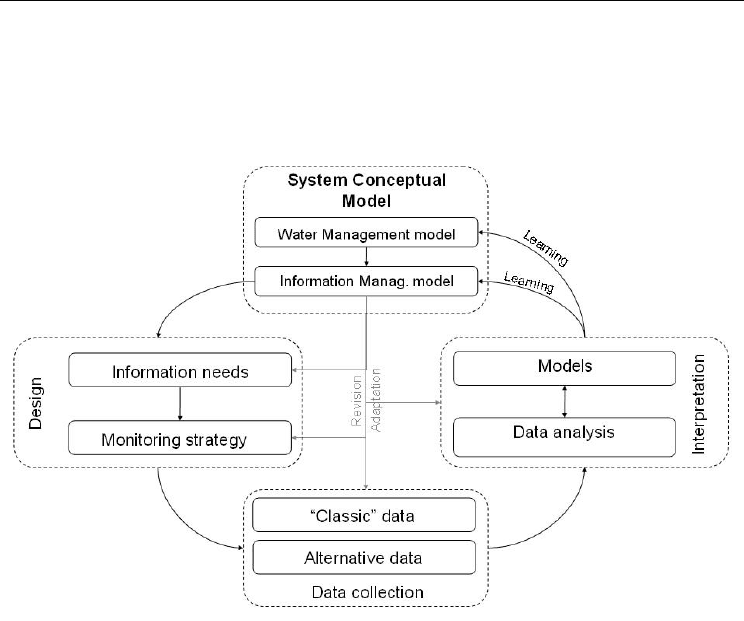
Monitoring Information Systems to Support Adaptive Water Management
431
3. Adaptive monitoring and information system
Considering the issues described in the previous section, the conceptual architecture of a
monitoring system for AM was defined (figure 1). From now onward, we refer to this
system as Adaptive Monitoring Information System (AMIS).
Fig. 1. AMIS conceptual architecture. The figure has been adapted from the Information
cycle elaborated by Timmerman and others (2000), to emphasise the two learning
processes.
As described previously, the basis for AMIS design is the conceptual model of the system,
which simplifies the system and makes the key components and interactions explicit. The
definition of this model is based on the integration between a participatory process,
allowing experienced stakeholders to provide their understanding of the system, and
models able to simulate future scenarios. The conceptual model is structured using the
integration between Cognitive Maps and Causal Loop Diagrams.
Two different conceptual models, i.e. the “water management conceptual model” and the
“information management conceptual model” are defined as the basis of AMIS. The former
concerns the interpretation of the problem considered, while the latter concerns the
information needed to solve the problem considered, and the “frames” used to interpret the
information (Pahl-Wostl, 2007; Kolkman et al., 2005).
The AMIS architecture consists of four main boxes, i.e. Conceptual model elicitation, Design,
Data collection and Interpretation. The links between them represent the iterative process of
monitoring design, which is at the basis of AMIS. The figure was elaborated starting from
the information cycle developed by Timmerman et al. (2000). This cycle depicts a framework
where information users and producers communicate information needs that link the

Environmental Monitoring
432
monitoring and decision processes. The monitoring program needs to be adapted to the
different stages of the policy definition process, because each stage requires different types
of information (Cofino, 1995; Ward, 1995) to make water management and governance
adaptive.
Two possible learning processes can be identified. The first one concerns the water
management conceptual model. Once information has been examined, a perspective is
developed, and an insight is gained and integrated into the conceptual model itself
(Kolkman et al., 2005). Information may prove initial models to be wrong and support the
debate between actors, which may lead to a revision of models, through reflection
and negotiation, in a social learning process. This learning may, in turn, support changes
in the water management conceptual model. Moreover, feedback on management
actions may generate new questions or new insights. This may make the originally agreed
upon information appear inadequate, resulting in new information needs. Thus,
the information needed to support a decision process evolves according to the actors’
learning process, leading to revision/adaptation in monitoring strategies and data
interpretation.
The second learning process relies on feedback from applied monitoring practices. As a
result of experience in implementing the monitoring program and assessing its results,
adaptation to monitoring may be needed (Cofino, 1995; Smit, 2003). The causes for
adaptation can be found within monitoring practices: too little attention may have been
spent on specifying the information needs; the information needs may have been specified
in such a way that no adequate information can be produced from it, or so that it does not
reflect the actual information users’ needs; the selected indicators may not adequately
measure what they are purported to measure; or the strategy to collect information may not
have produced the right information. Furthermore, the available budgets may restrict the
number of indicators that can be measured or the intensity of the network in terms of
locations and frequency. New information sources may become available (e.g. progress in
remote sensing technologies, etc.).
To this aim, an important innovation in AMIS concerns data collection methods. AM often
results in a demand to monitor a broad set of variables, with prohibitive costs if the
monitoring is done using only traditional methods of measurement. This is particularly
true in developing countries, where financial and human resources are limited. In these
areas, the monitoring network may cover only small part of the territory or the grid may
be too sparse, making the monitoring data unsuitable for the decision process.
Furthermore, traditional monitoring is costly, reducing its sustainability over time. The
resulting works may be still valuable as one-off assessments, but they do not provide
information about the trends of environmental resources and the evolution of
environmental phenomena. Thus, the outcomes of environmental policies are often
difficult to assess.
To deal with these issues, AMIS is based on the integration of alternative sources of
knowledge. Thus, AMIS can be considered as the shared platform through which traditional
monitoring information and innovative information sources (e.g. remote sensing
monitoring, community monitoring, etc.) are integrated. Therefore, AMIS is able to adapt to
data and information availability, supporting adaptive management even in data poor
regions.
In Table 1, a comparison between the conventional approach and monitoring to support
IWRM and AM is proposed.

Monitoring Information Systems to Support Adaptive Water Management
433
Current monitoring practices Needs for IWRM
- Based on monitoring objectives and
disciplinary needs
- Information users have unrealistic
expectations of the information that
will be produced
- Data accessibility is limited
- Abundant and detailed information is
provided
- The information provided is highly
specialised
- The available information is divided
over various organisations
- Information is transferred to the
information users
- Based on policy objectives and
information users’ needs
- The information that will be produced
is jointly agreed between information
users and producers
- Data are publicly available and
accessible
- The information provided is concise
and addresses the policy objectives
- The information is targeted towards
specific audiences
- The information combines results from
various organisations and is integrated
over disciplines
- Information is communicated to the
information users and a broader
stakeholder or public audience and
evaluated before being incorporated
into policy support
Additional needs for AM
- The outcomes of the monitoring
program (data) are the focus.
- The purpose of the monitoring program
is to evaluate environmental status set
against target values.
- Monitoring follows management and
policy implementation.
- The monitoring program design and the
responses on this design are as
important as the results: the focus is on
learning.
- Monitorin
g
becomes the primar
y
tool for
learning, i.e. understanding the system,
assessing the effectiveness of
management activities evaluating the
s
y
stem chan
g
es, and measurin
g
pro
g
ress
towards participatory defined goals.
- Monitoring, management and
governance are interdependent.
Table 1. Comparison among current, IWRM and AM monitoring
3.1 Learning process using AMIS
Learning aspects in the AMIS are not about the monitoring as a simple process or its data,
but about an increase of the system understanding, communication between stakeholders to
influence decision making (McIntosh et al., 2006). While giving floor to and later using
knowledge, concerns, demands, and expertise from different points of view, which result
from a stakeholder involvement, one will indeed achieve better decision making with more
alternatives of choice on the one hand, and a broader and more balanced acceptance of the
decision making in management.
To initiate and later-on ensure learning processes using a monitoring system, all relevant
stakeholder groups need access to it. Being involved when objectives are defined, data and
processes transparently observed, stakeholders get enabled to learn about variables and

Environmental Monitoring
434
interactions of “their own” systems and “their own” decisions which could lead to a
revision or adaptation of management decisions (Pahl-Wostl, 2007. Further, this creates the
feeling that stakeholders "buy in" into the product, that the monitoring system is “their” and
therefore deserves more credibility (McIntosh et al., 2006). According to recent approach, the
involvement of stakeholders can be extended to monitoring activities and not only to the
design phase. The use of local knowledge enhances the understanding of environmental
system, particularly in data poor areas. Moreover, adopting a community-based approach to
monitoring can promote the public awareness of environmental issues.
Thus the intensive dialogue between science and many different stakeholders offers the
opportunity for a mutual development, assessment, enhancement and implementation of
new or already existing concepts, methods and tools, and helps improve the quality and
acceptance of the decisions that are made. Last not least when using success-stories in
management, based on the AMIS design, for the further development and enhancement of
the monitoring system, the learning cycle is closed.
The following criteria, implemented into an AMIS, are indispensable to serve as a learning
tool (cf. McIntosh et al., 2006):
1. Understandability: for each group of participants one should use “professional”
indicators and perception-oriented “public” indicators to support learning processes for
both of them
2. Representativity in involvement. Regardless of the method used to solicit user groups
of the AMIS, every attempt should be made to involve a diverse group of stakeholders
or broad audience that represent a variety of interests regarding the issue addressed.
While key stakeholders should be invited to the process of indicator formulation, there
should be also an open invitation to all interested parties to join the evaluation of the
system. This adds to the public acceptance and respect of the results of the AMIS. If a
process is perceived to be exclusive, both key members of the decision-making
community and the wider public may reject monitoring.
3. Scientific credibility. Although participatory monitoring as it is understood in the
AMIS design incorporates values and beliefs, the scientific components of the
monitoring system must adhere to standard scientific practice and objectivity. This
criterion is essential in order to maintain credibility among all groups, expert-decision-
makers, scientists, stakeholders, and the public.
4. Objectivity. The stakeholder community must trust the facilitators of a participatory
monitoring as being objective and impartial. In this regard, facilitation by university
researchers or outside consultants often reduces the incorporation of stakeholder biases
into the scientific components of the monitoring system.
5. Understanding uncertainty. Understanding scientific uncertainty is critically linked to
the expectations of real world results associated with decisions made as a result of the
modelling process. This issue is best communicated through direct participation in the
modelling process itself.
6. AMIS’ own adaptability to incorporate new users groups, changed frameworks and
newly gained (quantitative and qualitative) data. The monitoring system developed
should be relatively easy to use and up-date by the administrators. This requires
excellent documentation and a good user interface. If non-scientist users cannot
understand the monitoring system as a source to work with, local decision-makers will
not apply it to support real management problems.
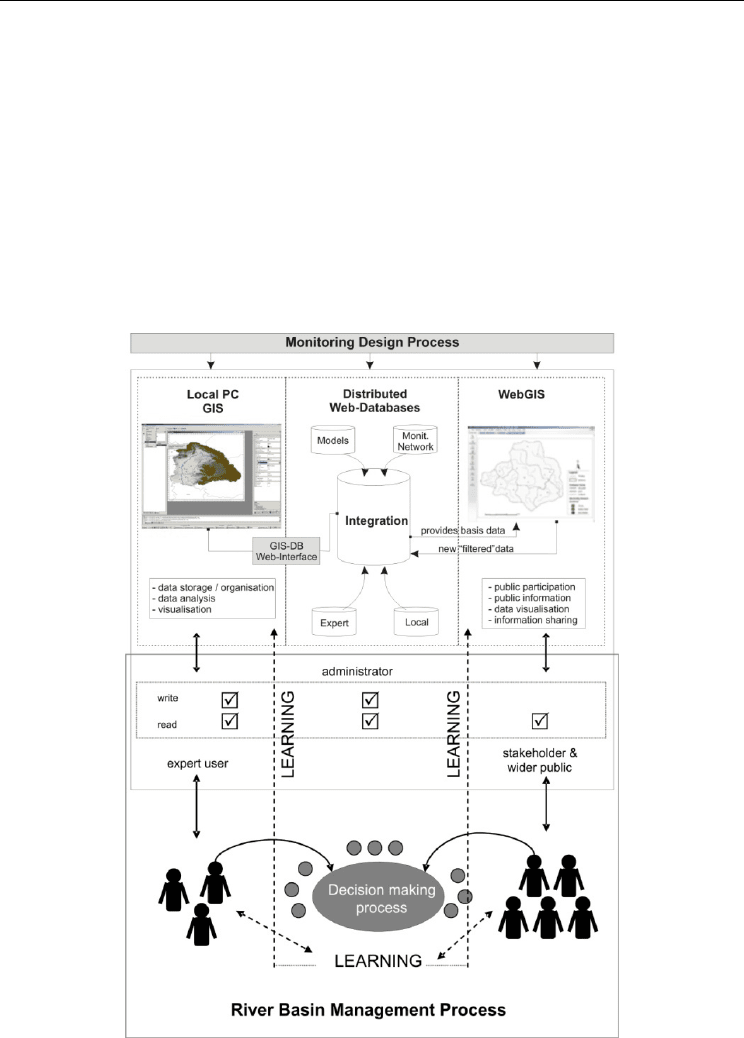
Monitoring Information Systems to Support Adaptive Water Management
435
3.2 Technical adaptability of an AMIS
In this section some technical aspects related to the adaptive degree of AMIS are described.
Firstly, AMIS should be flexible and able to incorporate new information and data, of
different type and with different formats. Using a relational database (RDBMS) is a sound
basis to be open for new information requirements, because it is very flexible and
extendable. The information can be well structured and redundancy can be avoided. The
user can create new tables and link them to the existing database.
To satisfy the information needs of various user groups according to their knowledge of
environmental system behaviour, different types of information for different purposes must
be produced. One important aim of the AMIS is to provide the user with various methods
and predefined algorithms to produce information. AMIS should provide the user with
user-friendly predefined methods and algorithms to produce information, such as data
visualisation tools as well as automatically generated information from incoming data.
Fig. 2. Technical components of AMIS.

Environmental Monitoring
436
Another aspect of being flexible and extendable is to provide the possibility to add new
modules easily, for instance hydrological or economical models, methods to analyse map
layers etc. This kind of flexibility is of interest for developers or advanced users with
programming skills. A modular or object oriented software structure is necessary to permit
this task.
Taking the above mentioned arguments into consideration the information system is quiet
flexible and open to include new information. But it is impossible to foresee what kind of
requirements will be demanded from the information system in a few years. Thus, it should
be possible to improve, maintain, and extend the software for everybody with programming
knowledge. To be “technically sustainable” open source software should be used and local
IT experts involved in the development process, particularly, if the software prototype will
be produced within a project over a certain period and not by a company. One should
emphasise the problem here that after a project has finished, often the developers are not
available or not in charge for the product anymore. To facilitate future improvements the
AMIS must be equipped with a sound documentation of the source code.
4. The adaptability of the groundwater monitoring system in Apulia Region:
Main drawbacks and potential improvements
The aim of this work is to criticize the current approaches to monitoring design,
highlighting the main drawbacks which hamper the adaptability of monitoring system.
Moreover, potential improvements are discussed. To this aim a framework to assess the
adaptability degree of monitoring design approach has been developed. The framework is
structured as shown in the following table.
Criteria Meaning
- Information
producer/information users
interaction
- Is the monitoring system based on the elicitation of
the decision-makers’ information needs?
- Degree of participation - How many actors have been involved in the process
of monitoring system design? At which level? In
which phase?
- Multi-scale monitoring - Is the monitoring system able to collect information
at different spatial and temporal scale?
- Integration of information
sources
- Is the monitoring system based on the integration of
different sources of data and information?
- Long time sustainability - Is the monitoring system capable to provide long
time series of data?
- Monitoring/modelling
interaction
- Is the monitoring system integrated with modelling
to support data analysis and interpretation?
- Policy evaluation - Is the monitoring system capable to support the
evaluation of the policy impacts and suggest
improvements?
- Monitoring evaluation - Does the monitoring program provide for an
evaluation and adaptation of the monitoring strategy?
Table 2. Comparison among current, IWRM and AM monitoring
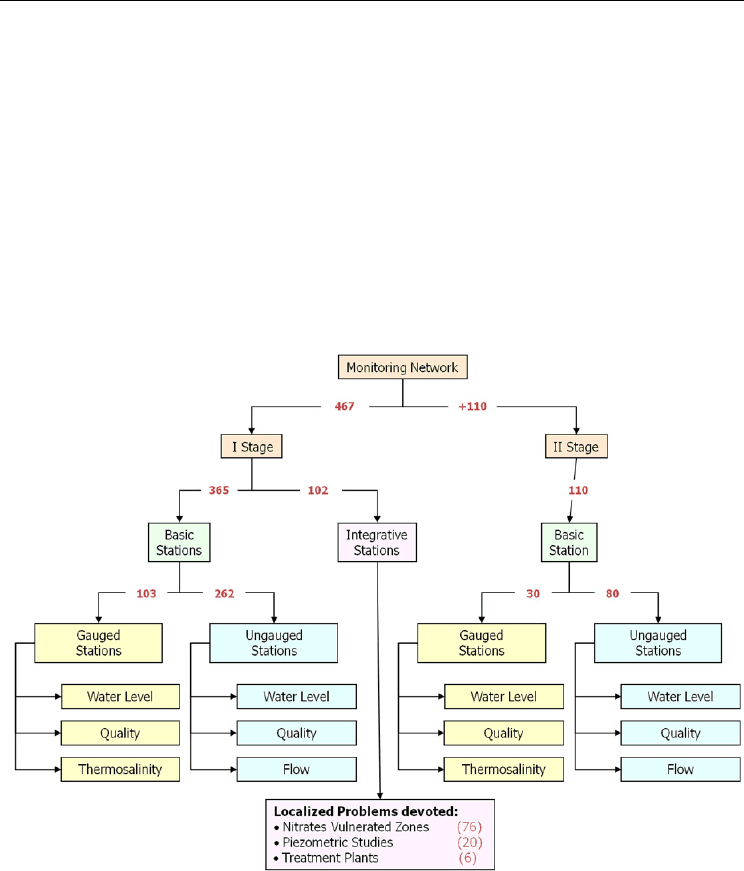
Monitoring Information Systems to Support Adaptive Water Management
437
This criteria have been used to evaluate the adaptability of the groundwater monitoring
system of the Apulia region (Southern Italy).
The groundwater monitoring network of the Apulia Region was established in 2006 to meet
the wide range of standards set by the water related national legislation adopted in 1999
(Italian Legislative Decree n. 152/1999). Consequently, the monitoring network was
designed, realized and finally used in order to produce water quality and quantity
information useful to characterize the environmental status of the main regional
groundwater bodies.
The monitoring network has been promoted and financed by the regional offices in charge
of the collection, storage and processing of data collected in accordance with relevant
regulations. The network design and implementation and the enforcement of the
monitoring practices fall within the scope of the project called TIZIANO whose completion
is scheduled for the end of 2011.
Fig. 3. TIZIANO monitoring design and number of monitoring stations. The process was
composed by two main phases to identify the monitoring stations.
The TIZIANO monitoring network is made of more than 600 wells mostly spread within the
boundaries of the four main aquifers of the region even if some tens of them have been
located within some minor groundwater bodies. About 130 wells have been equipped with
automatic probes for continuous measuring of groundwater level. During the last five years
hundreds of quality and quantity measures have been made on site and thousands of
samples, collected in the wells of the network, have been analyzed in laboratory in order to
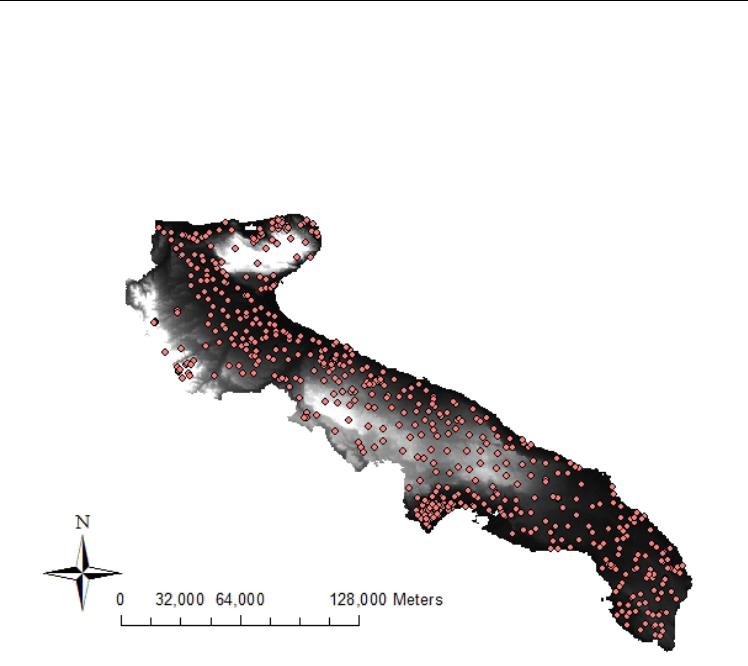
Environmental Monitoring
438
determine the concentration of the main chemicals, metals, organic compounds, pesticides
and level of harmful microorganisms. The huge amount of information, collected during the
last five years, was stored in a Geographic Information System (GIS) specifically designed
for the project. It allowed regional decision-makers to assess the environmental state of the
aquifers and plan and carry out specific actions to improve it, when not good, or reverse
worsening trends, when they were to lead to adverse conditions of groundwater quality and
quantity.
Fig. 4. Distribution of the monitoring station.
As reported above, the TIZIANO monitoring network started late in 2006, but the
administrative process which led to its design and funding started several years early, at the
turn of the century. In the meantime the European Union issued the Water Framework
Directive (2000/60/CE), which was implemented in Italy exactly in 2006 (Italian L.D. n.
152/2006), and the, so called daughter Groundwater Directive in 2006 (2006/118/CE),
recently implemented in Italy with the L.D. n. 30/2009. Although the Italian L.D. 152/1999
would herald a number of rules, then enshrined in European directives, it is evident that the
future implementation of the decrees of 2006 and 2009 have clarified and modified,
sometimes substantially, type, detail and timing of information to be acquired by
monitoring and all management activities resulting from its processing.
4.1 Information producer/information users interaction
The Region already had a modest, monitoring network made of about 100 piezometers
equipped with water level gauges, where some sporadic sampling was collected during the
early 90s. Nevertheless, because of various causes, this network was abandoned after some
years of functioning. At this point, within the regional offices in charge of water resources
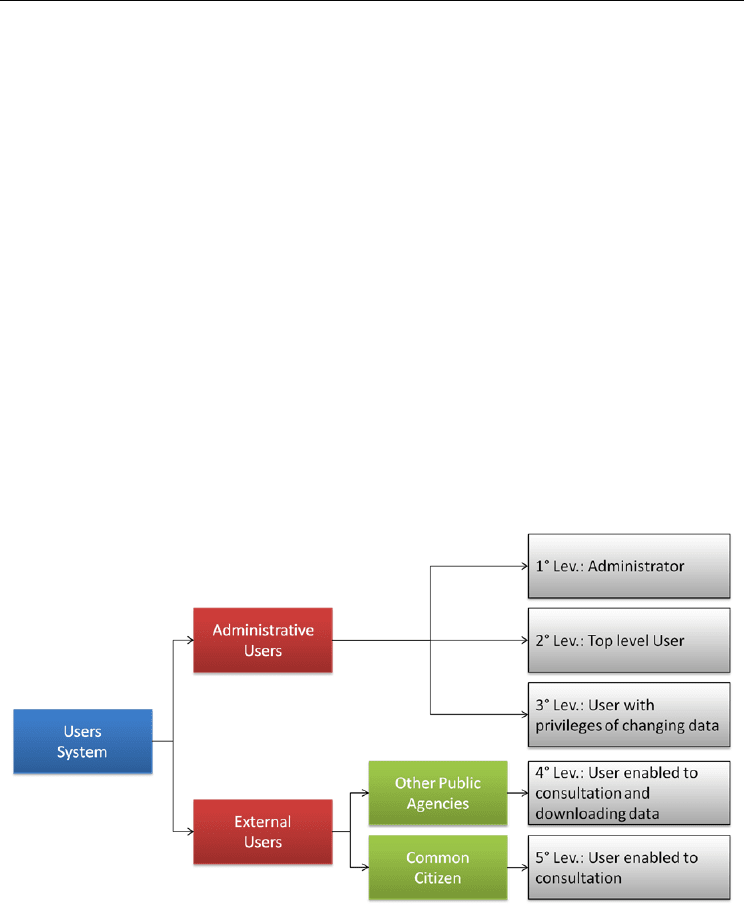
Monitoring Information Systems to Support Adaptive Water Management
439
management and protection, arose the need of recovering and, possibly, potentiate the
network.
In the meantime several important water related, European directives (e.g.: the Nitrate
Directive, 1991/676/EEC) and national decrees had been promulgated, which forced
regional water offices to move toward a detailed knowledge of the qualitative and
quantitative state of water resources in order to protect such resources and restore their
original natural status.
The evaluation of the institutional, legislative, technical and scientific needs and
expectations led to the design of the regional groundwater monitoring network by a small
team of super-experts which were careful to meet the requirements coming from various
and different parts. Measures of water level and physical-chemical parameters were carried
out following rules and times required by national environmental legislation implementing
EU rules and a number of scientific measures and controls were preformed in order to give
responses to the scientific community.
The information provided by the new monitoring system was essential, among other, in
order to assess the environmental state of the Apulian groundwater bodies or delimit
Nitrate Vulnerable Areas, and design and plan specific actions of different complexity and
socio-economical cost, able to recover and protect groundwater.
Summarizing, measures of water level and physical-chemical parameters were carried out
following rules and times required by national environmental legislation implementing EU
rules and a number of scientific measures and controls were preformed in order to give
responses to the scientific community.
Fig. 5. Information accessibility according to TIZIANO monitoring program.
4.2 Degree of participation
From what said above derives that the position of the decision-makers in the design of the
monitoring system was rather weak, i.e. the Apulian Region’s role was limited to promote
and fund the design. The role of decision-makers in the functioning of the TIZIANO
monitoring network is strong and constant. Regional offices are in charge of producing,

Environmental Monitoring
440
controlling and processing monitoring information in order to assess environmental indices
and plan and execute actions for recovering deteriorated resources.
4.3 Multi-scale monitoring
Given the multi-objective frame of the monitoring each class of data has been collected with
different spatial and temporal resolution. Let’s have a short description of classes of data
and related time-space scale starting from groundwater level.
In order to capture the cyclic behaviour of groundwater levels in the wells, measures are
taken on site almost every three months. About 130 wells have been equipped with
automatic water level gauges capable of acquiring and transmitting a measurement every 15
minutes. These equipped wells have been located at strategic sites, in order to use them as
controlling stations. So, the project database stores groundwater levels measured at different
temporal scales at different locations all over the aquifers extension. Nevertheless, there is
no analysis of the inter-linkages among the process at different scales.
4.4 Integration of information sources
Given the complexity of the monitoring network, the data collection system is extremely
various and includes manual and automatic measures, on site and laboratory analysis,
coastal and inland exploration, airborne remote sensing. The whole amount of collected data
is stored in GIS after a validation phase. Nevertheless, data coming from different platforms
are sporadically integrated. The different measures follow a separated path, which passes
through a separated validation step. In conclusion, the monitoring system is not based on a
strong integration between sources of data.
4.5 Long time sustainability
The whole monitoring system, as currently conceived, is particularly expensive. Let’s report
some of the main weakness of the project concerning its own costs.
The monitoring area is objectively wide and the number of monitoring points huge, while
the location of the monitoring teams is centralized and, consequently, they need to travel
hundreds of kilometres during the monitoring surveys or for maintenance. Instrumentation
need to be constantly maintained and often replaced due to theft.
Moreover the costs of the system are rather high due to the frequent outsourcing of
monitoring activities. Costs could be reduced dramatically, if most of the monitoring
practices were carried out by Regional Agencies and Offices and only very specialized
activities were outsourced. In conclusion, only if an intelligent redistribution of activities
within public institutions will be put in place, with a consequent cost reduction, the network
is likely to become a long-term system.
4.6 Monitoring/modelling interaction
Various statistical, geostatistical, hydrogeological and hydrogeochemical, deterministic and
stochastic, simple and complex models have been applied to process data collected and
stored into the GIS. Nevertheless, it was not specifically designed to be compliant to any
particular model. In fact, given the wide range of expected uses of the different dataset
stored the design choice was to keep the organization of data extremely simple, and then
easily adaptable to different kinds of models just through a simple pre-processor. In the
TIZIANO monitoring project, the monitoring/modeling interaction is one-directional. That
